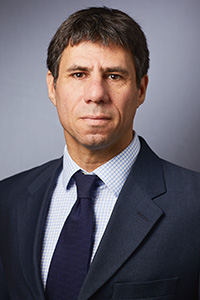PTSD Trauma Memories Are Not Represented in the Brain Like Other Memories, Study Suggests
PTSD Trauma Memories Are Not Represented in the Brain Like Other Memories, Study Suggests

Researchers studying the stories that people with PTSD tell about their traumatic experiences and then analyzing them in terms of the way they are represented in the brain by measuring patterns of firing neurons have found evidence that trauma memories are “an alternative cognitive entity” quite distinct from other representations of memory, including sad memories. The findings recently appeared in the journal Nature Neuroscience.
The question that drove the study, which was co-led by 2015 BBRF independent Investigator Ilan Harpaz-Rotem, Ph.D., of Yale University and Daniela Schiller, Ph.D., of the Icahn School of Medicine at Mount Sinai, was whether traumatic memory is “an exceptionally strong kind of sad autobiographical memory—or a different kind of neural representation altogether.“ John H. Krystal, M.D., of Yale, a BBRF Scientific Council member, 2019 BBRF Colvin Prize winner and 3-time BBRF grantee, was a co-author of the paper, whose first author was Ofer Perl, Ph.D., of Mount Sinai.
Previous research has established the role of the hippocampus in the formation of episodic memories—memories of events as they unfolded in space and time that enable a person to relate a sequence of events. Not only does the hippocampus enable us to construct narratives from discrete events; it is also involved in our ability to retrieve such memories. In PTSD, these capabilities of the hippocampus are thought to be impaired. PTSD also has been linked with structural changes in the brain, including a shrinking of the volume of the hippocampus and a loss of functional connectivity between the hippocampus and other brain areas.
One aim of the new study was to observe neural activation patterns in the hippocampus (among other brain areas) in PTSD patients while they were exposed to spoken accounts of their own memories.
The team used functional MRI (fMRI) imaging to examine neural activity in 28 patients with PTSD while they were listening to narratives based on their own accounts of their trauma, as well as two other types of their own memories. The patients, 11 of whom were female, were on average 38 years old. After being recruited, each was asked to elaborate on three types of autobiographical memories: one was the traumatic event associated with their PTSD; a second was a “sad” but meaningful experience that did not traumatize them (e.g., the death of a family member); a third was a neutral event, called the “calm” condition by the researchers (e.g., memory of a place one visited on vacation). Each of these memories was converted by the team to a 2-minute text which participants heard for the first time when they were read aloud by a member of the team while an fMRI scan was made.
Before the scans were analyzed, a separate “semantic content” analysis was performed of each participant’s three narratives. One object of this analysis was to see if the memories of the two emotionally negative experiences—the trauma and the sad experience--could be distinguished in strictly linguistic and semantic terms from one another and from the “calm” experience. Word-clouds based on the pooled results enabled the team to see how the three types of memories “clustered,” linguistically. Once this was established, it was then possible for the researchers to see if memories with similar linguistic structure and emotional content type could be correlated with patterns of neural activation revealed by the fMRI scans. For example, did linguistically similar accounts of negative memories (“sad” and “traumatic”) in different participants correlate with similar neural activation patterns in their brains?
This question generated one of the study’s most important results. Recounted memories of sad but non-traumatic memories—which were found to be linguistically similar—did indeed generate similar neural firing patterns in the hippocampus, across the participant group. In contrast, recounted traumatic memories were observed to generate different, highly idiosyncratic neural patterns in the hippocampus in each person. The traumatic narratives were similar linguistically across the group, but they did not generate similar or consistent activation patterns in the hippocampus.
Another brain area, the posterior cingulate cortex (PCC), which is involved in processing autobiographical memories, was also scrutinized in the fMRI scans. It too had a distinct way of responding to memories with similar emotional and linguistic content: the more severe the individual’s PTSD symptoms, the stronger the correlation between the linguistic features of the recalled memory and the neural response pattern.
The team drew these conclusions: first, two major brain systems involved in processing autobiographical memory, the hippocampus and PCC, represent the emotional content of recalled memories differently. Second, the processing of trauma memories appears to be unique in the hippocampus, in that it generates neural firing patterns that do not correlate with the linguistic or emotional content of triggered memories. The latter observation moved the team to ask: if trauma memories differ from merely “sad” memories in the way in which they are processed and represented in the hippocampus, why is this the case, and what might account for this?
Here, the researchers drew on extensive clinical experience with people with PTSD. It has been noted that traumatic memories are more difficult than other memories to be recounted as coherent narratives. “Indeed, a great deal of psychotherapy is geared toward reconstructing the traumatic event as a narrative,” the team notes—“one that is embedded within life-long memories, in the attempt to distance a past trauma from the current ‘safe’ present.”
This goal of “embedding” the trauma memory in personal history as prelude to establishing temporal and spatial distance from it is a way of enabling the patient to counter the intrusion that trauma memory often makes in everyday life—when no threat is present. The findings from the hippocampus in the new study may help explain the problem of intrusion at a biological and circuit level. It is possible, the researchers say, “that traumatic memory reactivation is not experienced as memory as such but is rather disconnected from time and space and from current surroundings.” This enables the intrusion of trauma to be “experienced as an intrinsic mental event,” in other words, not as other sad memories are processed, but “as an alternative cognitive entity that deviates from memory per se.”
The study’s results “are consistent with the notion that traumatic memories are not experienced as memories as such, but rather are fragments of prior events” whose intrusion into daily life effectively “subjugates the present moment.” One question raised by the study is how this perspective can help to inform and improve existing psychotherapies for PTSD. It will be interesting, for example, to investigate whether successful treatment for PTSD results in the hippocampal representation of the trauma becoming similar to representations of sad but non-traumatic memories in the same individual.




